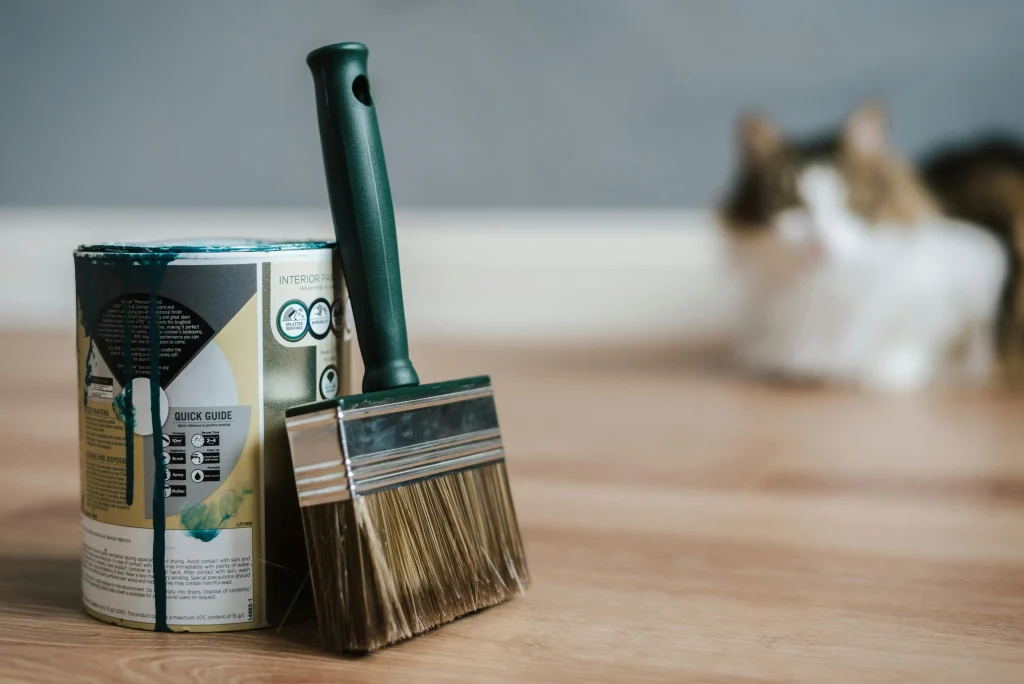Can You Paint Laminate Flooring? Yes, Here’s How!
Have you ever walked into a room and felt that the flooring just didn’t match the vibe you were going for? Maybe your laminate flooring is looking a bit dated, or perhaps it just doesn’t fit with your new decor.
Whatever the reason, replacing flooring can be an expensive and time-consuming project. But what if you could simply paint your laminate flooring instead?
Yes, you heard that right! Painting laminate flooring is a viable option for those looking to refresh their space without breaking the bank.
This guide will take you through everything you need to know about painting laminate flooring, from preparation to execution, and help you decide if it’s the right move for you.
Can You Paint Laminate Flooring?

First things first: can you actually paint laminate flooring? The short answer is yes, you can. However, it’s not as straightforward as painting a wall or even wooden floors.
Laminate flooring is made from a synthetic material designed to resist wear and tear, which means it doesn’t hold paint as well as more porous surfaces.
Before you dive into this project, consider the condition of your laminate flooring. If it’s heavily damaged or warping, painting might not solve your problems.
Additionally, think about the room’s usage. High-traffic areas might wear down the paint faster, leading to more maintenance in the long run.
Painting laminate flooring is a great way to update the look of a room, especially if you’re on a budget or short on time. But like any DIY project, it comes with its own set of challenges and considerations. Understanding these will help you decide if painting your laminate flooring is worth the effort.
Preparing to Paint Laminate Flooring
Preparation is key when it comes to painting laminate flooring. Skipping steps here can lead to a subpar finish that won’t stand the test of time. Here’s what you’ll need and how to get started.
Materials and Tools Needed
Before you begin, gather all the necessary materials and tools. You’ll need:
- A good quality primer
- Paint suitable for floors (latex or oil-based)
- Polyurethane or a similar sealant
- Sandpaper (220-grit)
- A sanding block or electric sander
- Cleaning supplies (vacuum, mop, mild detergent)
- Paint rollers and brushes
- Painter’s tape and drop cloths
Preparation Steps
- Clean the Floor Thoroughly: Start by cleaning your laminate floor to remove any dirt, dust, or grease. Use a mild detergent and water, then let it dry completely. This step ensures that the paint adheres properly to the surface.
- Sanding the Surface: Sanding is crucial for ensuring that the primer and paint adhere to the laminate. Use 220-grit sandpaper to lightly sand the entire surface. You don’t need to remove the laminate finish entirely; just roughen it up enough for the primer to stick. After sanding, vacuum up the dust and wipe the floor with a damp cloth to remove any remaining particles.
- Applying Primer: Primer helps the paint bond to the laminate. Choose a high-quality primer that is designed for non-porous surfaces. Apply a thin, even coat with a roller, using a brush for edges and corners. Let it dry completely according to the manufacturer’s instructions before moving on to painting.
Painting Laminate Flooring
Now that your floor is prepped and primed, it’s time for the fun part: painting! Here’s how to choose the right paint and get the job done right.
Choosing the Right Paint
Selecting the right paint is crucial for a durable finish. Look for latex or oil-based paint specifically designed for floors. These paints are more durable and can withstand foot traffic better than regular wall paint. Some brands offer paint specifically formulated for laminate surfaces, which can provide even better adhesion and durability.
Step-by-Step Painting Process
- Start with the First Coat: Pour your chosen paint into a tray and load your roller. Apply the paint in thin, even coats, working in small sections. Use a brush for edges and corners. Avoid applying too much paint at once to prevent drips and uneven coverage.
- Let It Dry: Allow the first coat to dry completely. This can take several hours or even overnight, depending on the paint and environmental conditions.
- Apply Additional Coats: Most laminate floors will require at least two coats of paint. Repeat the painting process, ensuring each coat is fully dry before applying the next. This will help achieve a smooth, even finish.
- Final Touches: Once you’re satisfied with the coverage, let the final coat dry thoroughly. This may take up to 24 hours.
Sealing the Paint
Sealing your painted laminate floor is essential for durability. A polyurethane sealant will protect the paint from wear and tear, spills, and scratches. Choose a water-based polyurethane for easier application and quicker drying time.
- Apply the Sealant: Use a clean roller or brush to apply a thin, even coat of sealant over the painted floor. Be sure to follow the manufacturer’s instructions for drying times and re-coating.
- Let It Cure: Allow the sealant to cure fully before walking on the floor or replacing furniture. This can take up to a week, but the result will be a more durable and long-lasting finish.
Pros and Cons of Painting Laminate Flooring
Like any home improvement project, painting laminate flooring comes with its own set of pros and cons. Weighing these can help you decide if this is the right solution for your space.
Benefits
- Cost-Effective: Painting your laminate flooring is significantly cheaper than replacing it. This is a major advantage if you’re working with a tight budget.
- Quick Refresh: A new coat of paint can completely transform a room, giving it a fresh, updated look without the hassle of a full renovation.
- Customizable: Painting allows you to choose any color you want, making it easy to match your existing decor or try out a new style.
Potential Drawbacks
- Durability Concerns: Painted laminate floors may not hold up as well in high-traffic areas. The paint can chip or wear down over time, requiring touch-ups or re-painting.
- Preparation Time: Proper preparation is crucial for a successful paint job. Skipping steps can result in a finish that doesn’t last, which can be frustrating and time-consuming to fix.
- Maintenance Requirements: Painted floors may require more maintenance than their unpainted counterparts. You’ll need to be careful with cleaning to avoid damaging the paint and sealant.
Conclusion
Painting laminate flooring can be a great way to give your space a fresh look without the cost and hassle of replacing the floor. With proper preparation and the right materials, you can achieve a durable and attractive finish that breathes new life into your home. However, it’s important to weigh the pros and cons to ensure this solution fits your needs and expectations.
If you’re ready to tackle this project, follow the steps outlined in this guide, and you’ll be on your way to a beautifully painted floor. And remember, the key to success lies in the details: thorough preparation, quality materials, and careful application.
Related Articles

